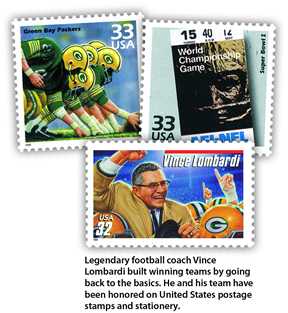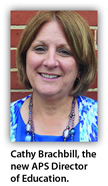
Reviews of Long-Range Plans in Key Areas are Underway
also available in .pdf format


Vince Lombardi, best known as the coach of the Green Bay Packers, was the most successful coach in the National Football League. His career winning percentage was .740, winning nearly three of every four games, six NFL Championships and two Super Bowls. Since 1971 every Super Bowl Champion has been awarded the Vince Lombardi Trophy as the symbol of excellence.
That is not to say he did not know frustration. In 1960, the Packers played for the NFL championship against the Philadelphia Eagles. Though the Packers, with Bart Starr as quarterback, took a fourth quarter lead, they let the Eagles immediately score and re-take the lead. Despite Lombardi and Starr’s best efforts, the Packers fell short on the next scoring drive, losing the NFL title.
When the Packers came together for training camp in July 1961, the team waited for Lombardi; with some expectation he was going to let loose the frustration of months. What they got instead was a simple introduction. Lombardi walked into the locker room, football in hand, and gathered the team around. “Gentlemen,” Lombardi started, “this is a football.”
Even though the team had come within minutes of winning a championship months before, Lombardi decided to start with the fundamentals of football. Where the lines were, the end zone, what each position was and how it contributed to the team’s success — to borrow the oldest of sports clichés — back to the basics.
The result of that speech and philosophy speak volumes. The Packers would not only win the NFL championship in 1961, but again in 1962 and another impressive run from 1965 to 1967, including the first two Super Bowls. (Yes, we know it wasn’t officially called the “Super Bowl” until 1969.) Lombardi’s success was challenging every player to forget what they knew and learn it all over again.
Unfortunately, our membership has declined for 20 years and revenues have matched. The good news is the American Philatelic Society remains fundamentally sound, but this is our opportunity to “get back to the basics” and start building the organization we know it can be.

In 2010, the Long Range Planning Committee released a report titled, “Into the Future” which you can read online at stamps.org/userfiles/file/reports/IntoTheFuture_Report.pdf.

The report is admittedly ambitious, projecting what the world of philately would be like in 2030 and how the APS should be positioned to meet the needs of collectors then. Progress was made on the report, but five years later, we are ready to review the plan and make appropriate course corrections.
Members of the APS and APRL boards will examine this strategic plan and how we can address some of our challenges in the near term. That final product will be presented to our members and the respective boards by January to become our new playbook. The plan we present should be a multi-year plan, but try to look no further than 2020. In future Our Story columns, I will discuss each of these topics in greater detail, but for now, our challenges are: sustainability, education, accessibility, and membership.
Membership
We have averaged approximately a 1,000-member loss each year. Typically, once someone is a member, they are likely to stay a member. Where our biggest challenge lies is in recruitment of new members. Through the years, we have tried different approaches to add members, with some results, but not nearly enough.
Initially, we will take the various committees created over the years to form one committee focused on all aspects of membership, specifically recruitment, retention, and services. This committee will build the plan and work to bring the resources and knowledge to take us from good to great.

Education
In the “Into the Future” plan, the APS goal in 2010 was to increase the number of online courses by 2015. Today, we offer a series of courses, mostly in person to adult collectors and a handful of programs to youth collectors. In education, the goal is to meet the needs of various skills — teach from novice to experienced, and all points in between. We are successful in certain areas, but we do not have a comprehensive education plan expected by this point. We recently hired Cathy Brachbill, a former classroom teacher and curriculum instructor, to be the APS Director of Education. At the same time, we are bringing together all of the education-related committees under one umbrella to better integrate our education services to reach both youth and adult members, entry-level to experienced.
Accessibility
Today, we need to be accessible from near and far — and typically around the clock.
We have made progress providing The American Philatelist online and our library has provided more digital access than ever before.
Accessibility also means preservation of the materials we use. In some cases, our holdings are older, fragile, and even rare and need special care.
If we do not make preservation a top priority, it may be too late. In order to accomplish this, we are asking the Technology Committee to bring together a long-term technology plan and help identify the resources to accomplish the mission.
Sustainability
All of our activities require resources and for nine years, APS membership has remained at $45 a year.
For some of our members, this represents a significant investment and for other members, it is a small cost and they have generously given more of their money, resources, and time for the good of the APS and philately.
There is no single answer to keeping the APS on a sustainable operating track.
We will continue to work with members to give them the best value for their membership, offering ways to make larger contributions, and allow a legacy of giving long after they are gone.
After a break of almost a year, the Campaign for Philately has come back together to reignite our development resources — fundraising, grants, and bequests and estates — to better serve the collecting community at large.
Thankfully, the future of the APS and philately is serious enough that our members are willing to give their time, knowledge, and even funding to support.
However, there is no single person who holds the right answer and so we invite all of our members to give us your best ideas or suggestions.
Please feel free to send them to [email protected].
It does not matter if it’s been thought of before, failed before, or seems like no one else has ever been interested in listening — when we get back to the fundamentals, the sheet is clean and we start again.
So, to borrow on the phrase from Coach Lombardi, “Ladies and gentlemen, this is a stamp.”




